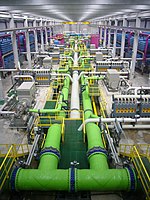
Photo from wikipedia
Abstract To effectively remove total Cr from wastewater, a novel composite membrane (PEI/MOF@PVDF) was successfully prepared by depositing UiO-66-NH2 and subsequently cross-linking with polyethylene imine (PEI) based on polyvinylidene fluoride… Click to show full abstract
Abstract To effectively remove total Cr from wastewater, a novel composite membrane (PEI/MOF@PVDF) was successfully prepared by depositing UiO-66-NH2 and subsequently cross-linking with polyethylene imine (PEI) based on polyvinylidene fluoride (PVDF). UiO-66-NH2 was mainly immobilized on the membrane surface and finger-like pore, which reduced the hydrophilicity and improve the surface positive charge, while the cross-linked PEI not only sufficiently covered this shortage but also enhanced the stability of membrane. PEI/MOF@PVDF owned such a high pure water flux as 561 L/(m2·h), meanwhile the water flux of BSA-contaminated membrane could be restored to 96.13%. This is the first work focusing on the efficient co-removal of both Cr(VI) and Cr(III) with the novel positively charged UiO-66-NH2 decorated ultrafiltration membrane (PEI/MOF@PVDF). Interestingly, the effluent concentration of Cr(VI) was broke through at effective treatment volume of 2322.23 L/m2 which was mainly charged by electrostatic attraction with the positive pores. And the effluent concentration of Cr(III) was consistently stable because of Donnan effect on the positive membrane. The EDS mapping revealed that Cr(VI) was preferentially adsorbed in the membrane pores for their high potential with highly concentrated UiO-66-NH2, while Cr(III) was mainly rejected on the positive surface. Moreover, PEI/MOF@PVDF showed negligible leakage of UiO-66-NH2 owing to the successful cross-link of PEI and the membrane can be easily regenerated and reused. Thus, the newly-developed composite membrane showed a promising potential for the efficient co-removal toward both Cr(VI) and Cr(III) in treating authentic wastewater.
Journal Title: Chemical Engineering Journal
Year Published: 2021
Link to full text (if available)
Share on Social Media: Sign Up to like & get
recommendations!